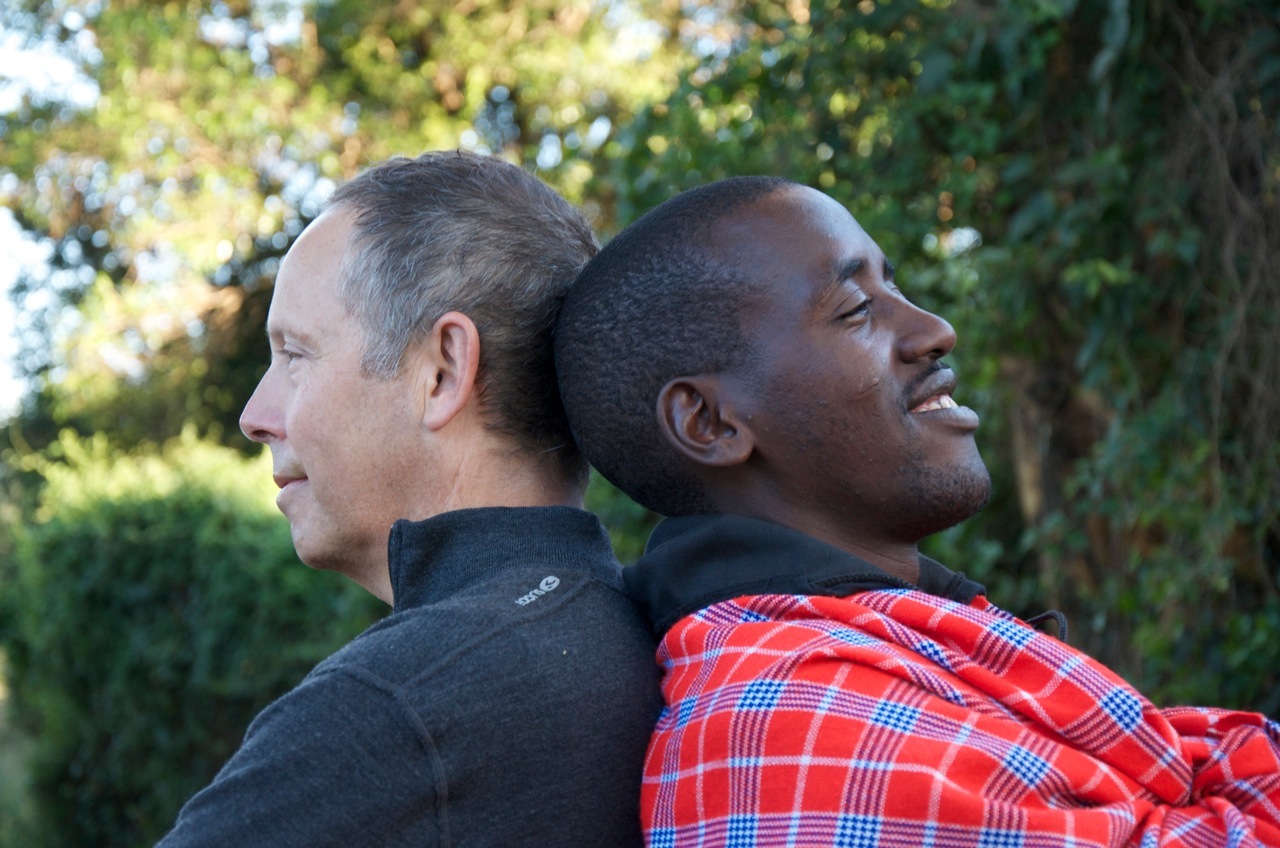The Power of Walking Conversations
“To keep your balance, you must keep moving. ”
A Walk in Kenya
Kenya in October can be hot—especially if you’re walking on the African savannah, the Masai Mara, in the middle of the day. I was traveling with Karea, a lovely Kenyan man of about thirty-five, with a huge smile and an easy laugh. I was running an annual service learning retreat in Kenya, which offered an opportunity for attendees to walk for the day with a Maasai warrior. Our hosts, the international youth empowerment and development organization, Free the Children, worked closely with numerous rural communities, and employed our guides, including Karea.
He and I were to spend half a day walking about eight miles toward a gathering in a local community. He wore a shuka, the traditional Maasai long red-checked wrap, and carried a spear, a bow and quiver of arrows, and a wooden club called a rungu. One important aspect of his work that day was to guide and protect me on our journey from snakes, lions and anything else unwanted that might come our way. As we discovered on our walk, we also shared an unspoken goal: to connect with each other across the divide of culture and language. Karea spoke twice as much English as I did Swahili. Unfortunately, I spoke only ten words of Swahili, and one word of Ma, his native language. No matter how enthusiastically I said, “Sopa,” basically, “What’s up?” it only got me so far.
As we started out across the Kenyan plain, the prospect of an in-depth discussion seemed as distant as the far-away horizon. Initially, this is how it went: we walked; then after awhile, Karea would point, say something in Swahili or Ma—I couldn’t tell the difference—and then mime. I’d shrug, look clueless, he’d smile helplessly, and we’d walk again. He’d try again. Same results. Then we’d walk a long time in silence. Stop. Drink. Walk some more, and I’d try from my end. He’d smile his big smile, which meant, “Sorry, I don’t understand,” and again, we’d walk. If I thought I understood a word or short phrase, I’d keep repeating it as a sign of my growing linguistic abilities. At one point, I confused the word “heart” for “breast,” which was good for a huge laugh later in the day among our hosts. Karea was far too polite at the time to stop me from basically saying his wife had “big hoo-ha’s.”
At times our walk was quiet, and at times, energetic, as we exchanged comments and observations even though it seemed we couldn’t understand each other. Whatever else the conversation was, it was always moving. And as we moved, something magical began to happen. Regardless of the actual words we used, the essence of our connection deepened, and with it our rudimentary conversation.
At the end of our time we gathered with the other people from our travel group to share our experiences and introduce our new friends. When it came time for Karea to introduce me, through a translator he spoke eloquently about our deep connection, of all we learned about our families, and of his new great friend. He gave me a Maasai name, Lemayan, which means, “One who loves to walk and talk.” I don’t know how he did it, but the guy totally understood me. Karea understood me between the words we spoke and not because of them.
I began thinking about what was different on the savannah in that moving conversation, devoid of the usual social and cultural trappings. I considered how, in my work as an organizational consultant, I have often relied on walking as a way to create significant transformational conversations. And there have been some extraordinary walking discussions—with Jane Goodall, Steve Jobs, and along the Syrian border in Turkey leading a walking meeting of regional leaders following the path of Abraham.
I often weave walking into my work, and because of this I’ve noticed something that is beyond just a deep love for that process of moving through a landscape or a neighborhood that, for me, goes back to childhood. There is something about walking and talking that’s dissimilar to sitting for the dialogue. Maybe it’s the full inclusion of our bodies, the lack of eye contact or what’s culturally imbedded in our notions of safety. Maybe it’s just being outside. Whatever the reason, one thing feels clear: when we walk and talk versus sit and talk, the quality of communication feels different.
The earliest root of the word walk is wel, meaning, “to turn, bend, twist, roll,” and that is what walking and talking does. In the act of moving forward together, something in our nature is affected. If we’re lucky, we can be reshaped or deepened by the conversations that happen when we move. If we are really lucky, we can be transformed.
I am not suggesting the replacement of all sitting conversations with moving ones. Face to face is the way our lives largely get done, particularly for in-person conversations, whether at the family table or in meetings. Technology aside, we are a species that grew from seeing each other face-to-face.
When it comes to communication, one other thing is abundantly clear: we spend a lot of time doing it. Most of our days, in one form or another, we spend in expression. With the world growing in people, challenges and complexity, a case can be made that of all the things we need to improve, the way we communicate should be at the top of the list.
But let’s face it, talking at a table has only gotten us so far. As a species we are running out of options. The political process is a mess, divorce continues at an all-time high, our young people are being lured away by technology, and the global economic and environmental situation is, well, let’s just say it’s not good. Maybe it’s time to ask ourselves: What are our options?
If we really want to move our thinking and the thinking of others forward, perhaps we should literally move. Because we are a walking species, having populated the planet using our feet.
Why Walking Works
The question is why does walking work? Experience shows the reason is less one specific thing, but rather a collection of critical items that like a good dinner party make the overall outcome a success. It’s never just the food, or just the guests, or just the setting, but when in thoughtful combination magic occurs. A great dinner party is one plus one plus one equals nine!
What follows are some of the ingredients for why walking conversations.
First, when we move, everything in our bodies is engaged, and as a consequence, we become more open and stimulated. The external environment and the motion stimulate our nervous system, making it more highly activated, which keeps us focused and present. When conversation takes this kinesthetic form, our intuition and creativity are activated because both mind and body are engaged.
The new and expanding field of brain science offers other kinds of possibilities. Body movement triggers bilateral brain functioning, which enables creativity and expansive thinking. Just being outside, with its changing environment, has impacts on the brain. Fresh air, and the possibility of nature, all help with freedom of thought and broadness in perspective. The outside world is always in flux, with stimulation and movement triggering our brains to be more active and energetic. It resets our brain to become more expansive, with a calmer emotional state as a result.
Traditional conversations often operate at the speed of the fastest people. Those would be the one’s quickest with ideas, or most aggressive in opinion. But a walking conversation always moves at the pace of the slowest member, which generates a feeling of engagement and inclusion. When I slow down to meet you with my feet I also slow down my thinking to meet your ideas and point of view.
Side-by-side talking is less challenging. For some, too much direct eye contact is threatening, so when eye contact is removed, the space in between just feels safer. Side-by-side feels more protected. On some level, we are still animals with evolutionary instincts, so maybe it’s because our vital organs are less exposed shoulder-to-shoulder, or we’re avoiding the primal predatory trigger of the eye–to-eye challenge.
Finally, there is silence, what Cicero called “one of the great arts of conversation.” Moving, the silence feels more natural. Most of us think better when we have a sense of space, and silence provides the vehicle for that space; it’s a powerful force. The trouble is when we’re silent for more than a few seconds in a face-to-face sitting conversation, it’s a rare person who can be comfortable with it. Walking removes most of the awkward discomfort that can follow a stretch of no words. We have things to look at, next steps to take, places for our minds to actively seek, and this fills a void that sitting can never provide. As a consequence, silence becomes easier, and we gain the benefit of its value.
So, the next time you have a critical conversation, push away from where you are sitting, and ask, “Want to go for a walk?”
Upcoming Walk2Talk Workshop
To learn more about an upcoming walking retreat with David in British Columbia this summer, read this post or visit the Hollyhock Institute website to register.


